Use of an Artificial Neural Network for Tensile Strength Prediction of Nano Titanium Dioxide Coated Cotton
Abstract
:1. Introduction
2. Material and Methods
2.1. Material and Experimental Design
2.2. Artificial Neural Network
3. Results and Discussion
3.1. Structural Analysis
3.2. Analysis of the Proposed ANN Model
4. Conclusions
Author Contributions
Funding
Institutional Review Board Statement
Informed Consent Statement
Data Availability Statement
Conflicts of Interest
References
- Noman, M.T.; Ashraf, M.A.; Ali, A. Synthesis and applications of nano-TiO2: A review. Environ. Sci. Pollut. Res. 2018, 26, 3262–3291. [Google Scholar] [CrossRef] [PubMed]
- Noman, M.T.; Militky, J.; Wiener, J.; Saskova, J.; Ashraf, M.A.; Jamshaid, H.; Azeem, M. Sonochemical synthesis of highly crystalline photocatalyst for industrial applications. Ultrasonics 2018, 83, 203–213. [Google Scholar] [CrossRef]
- Noman, M.T.; Wiener, J.; Šašková, J.; Ashraf, M.A.; Viková, M.; Jamshaid, H.; Kejzlar, P. In-situ development of highly photocatalytic multifunctional nanocomposites by ultrasonic acoustic method. Ultrason. Sonochem. 2018, 40 Pt A, 41–56. [Google Scholar] [CrossRef]
- Noman, M.T.; Ashraf, M.A.; Jamshaid, H.; Ali, A. A Novel Green Stabilization of TiO2 Nanoparticles onto Cotton. Fibers Polym. 2018, 19, 2268–2277. [Google Scholar] [CrossRef]
- Liu, X.; Gasco, F.; Goodsell, J.; Yu, W. Initial failure strength prediction of woven composites using a new yarn failure criterion constructed by deep learning. Compos. Struct. 2019, 230, 111505. [Google Scholar] [CrossRef]
- Balram, D.; Lian, K.Y.; Sebastian, N.; Al-Mubaddel, F.S.; Noman, M.T. Bi-functional renewable biopolymer wrapped CNFs/Ag doped spinel cobalt oxide as a sensitive platform for highly toxic nitroaromatic compound detection and degradation. Chemosphere 2022, 291, 132998. [Google Scholar] [CrossRef]
- Chen, R.; Mihaylova, L.; Zhu, H.; Bouaynaya, N. A Deep Learning Framework for Joint Image Restoration and Recognition. Circuits Syst. Signal Process. 2020, 39, 1561–1580. [Google Scholar] [CrossRef] [Green Version]
- Zazoum, B.; Triki, E.; Bachri, A. Modeling of Mechanical Properties of Clay-Reinforced Polymer Nanocomposites Using Deep Neural Network. Materials 2020, 13, 4266. [Google Scholar] [CrossRef] [PubMed]
- Sebastian, N.; Yu, W.C.; Balram, D.; Al-Mubaddel, F.S.; Noman, M.T. Functionalization of CNFs surface with β-cyclodextrin and decoration of hematite nanoparticles for detection and degradation of toxic fungicide carbendazim. Appl. Surf. Sci. 2022, 586, 152666. [Google Scholar] [CrossRef]
- Vahid, A.; Mückschel, M.; Stober, S.; Stock, A.; Beste, C. Applying deep learning to single-trial EEG data provides evidence for complementary theories on action control. Commun. Biol. 2020, 3, 112. [Google Scholar] [CrossRef] [Green Version]
- Balram, D.; Lian, K.Y.; Sebastian, N.; Al-Mubaddel, F.S.; Noman, M.T. A sensitive and economical electrochemical platform for detection of food additive tert-butylhydroquinone based on porous Co3O4 nanorods embellished chemically oxidized carbon black. Food Control 2022, 136, 108844. [Google Scholar] [CrossRef]
- Sebastian, N.; Yu, W.C.; Balram, D.; Al-Mubaddel, F.S.; Noman, M.T. Nanomolar detection of food additive tert-butylhydroquinone in edible oils based on novel ternary metal oxide embedded β-cyclodextrin functionalized carbon black. Food Chem. 2022, 377, 131867. [Google Scholar] [CrossRef] [PubMed]
- Daniel, G.G. Artificial Neural Network. In Encyclopedia of Sciences and Religions; Runehov, A.L.C., Oviedo, L., Eds.; Springer: Dordrecht, The Netherlands, 2013; p. 143. [Google Scholar] [CrossRef]
- Amor, N.; Noman, M.T.; Petrů, M. Prediction of functional properties of nano TiO2 coated cotton composites by artificial neural network. Sci. Rep. 2021, 11, 12235. [Google Scholar] [CrossRef] [PubMed]
- Amor, N.; Noman, M.T.; Petrů, M.; Mahmood, A.; Ismail, A. Neural network-crow search model for the prediction of functional properties of nano TiO2 coated cotton composites. Sci. Rep. 2021, 11, 13649. [Google Scholar] [CrossRef] [PubMed]
- Lu, D.; Yu, W. Predicting the tensile strength of single wool fibers using artificial neural network and multiple linear regression models based on acoustic emission. Text. Res. J. 2021, 91, 533–542. [Google Scholar] [CrossRef]
- Gayatri Vineela, M.; Dave, A.; Kiran Chaganti, P. Artificial Neural Network based Prediction of Tensile Strength of Hybrid Composites. Mater. Today Proc. 2018, 5, 19908–19915. [Google Scholar] [CrossRef]
- Mishra, S. Prediction of Yarn Strength Utilization in Cotton Woven Fabrics using Artificial Neural Network. J. Inst. Eng. (India) Ser. E 2015, 96, 151–157. [Google Scholar] [CrossRef]
- Malik, S.A.; Farooq, A.; Gereke, T.; Cherif, C. Prediction of Blended Yarn Evenness and Tensile Properties by Using Artificial Neural Network and Multiple Linear Regression. Autex Res. J. 2016, 16, 43–50. [Google Scholar] [CrossRef] [Green Version]
- Altarazi, S.; Allaf, R.; Alhindawi, F. Machine Learning Models for Predicting and Classifying the Tensile Strength of Polymeric Films Fabricated via Different Production Processes. Materials 2019, 12, 1475. [Google Scholar] [CrossRef] [Green Version]
- Erbil, Y.; Babaarslan, O.; İlhami, I. A comparative prediction for tensile properties of ternary blended open-end rotor yarns using regression and neural network models. J. Text. Inst. 2018, 109, 560–568. [Google Scholar] [CrossRef]
- Breuer, K.; Stommel, M. Prediction of Short Fiber Composite Properties by an Artificial Neural Network Trained on an RVE Database. Fibers 2021, 9, 8. [Google Scholar] [CrossRef]
- Wang, F.; Chen, Z.; Wu, C.; Yang, Y.; Zhang, D.; Li, S. A model for predicting the tensile strength of ultrafine glass fiber felts with mathematics and artificial neural network. J. Text. Inst. 2021, 112, 783–791. [Google Scholar] [CrossRef]
- Liu, F.; Ding, W.; Qiao, Y.; Wang, L. An artificial neural network model on tensile behavior of hybrid steel-PVA fiber reinforced concrete containing fly ash and slag power. Front. Struct. Civ. Eng. 2020, 14, 1299–1315. [Google Scholar] [CrossRef]
- Amor, N.; Noman, M.T.; Petrů, M. Prediction of Methylene Blue Removal by Nano TiO2 Using Deep Neural Network. Polymers 2021, 13, 3104. [Google Scholar] [CrossRef] [PubMed]
- Amor, N.; Noman, M.T.; Petrů, M. Classification of Textile Polymer Composites: Recent Trends and Challenges. Polymers 2021, 13, 2592. [Google Scholar] [CrossRef] [PubMed]
- Mahmood, A.; Noman, M.T.; Pechočiaková, M.; Amor, N.; Petrů, M.; Abdelkader, M.; Militký, J.; Sozcu, S.; Hassan, S.Z.U. Geopolymers and Fiber-Reinforced Concrete Composites in Civil Engineering. Polymers 2021, 13, 2099. [Google Scholar] [CrossRef] [PubMed]
- Noman, M.T.; Petrů, M. Functional Properties of Sonochemically Synthesized Zinc Oxide Nanoparticles and Cotton Composites. Nanomaterials 2020, 10, 1661. [Google Scholar] [CrossRef]
- Jeon, J.H.; Yang, S.S.; Kang, Y.J. Estimation of sound absorption coefficient of layered fibrous material using artificial neural networks. Appl. Acoust. 2020, 169, 107476. [Google Scholar] [CrossRef]
- Doran, E.C.; Sahin, C. The prediction of quality characteristics of cotton/elastane core yarn using artificial neural networks and support vector machines. Text. Res. J. 2020, 90, 1558–1580. [Google Scholar] [CrossRef]
- Jierula, A.; Wang, S.; OH, T.M.; Wang, P. Study on Accuracy Metrics for Evaluating the Predictions of Damage Locations in Deep Piles Using Artificial Neural Networks with Acoustic Emission Data. Appl. Sci. 2021, 11, 2314. [Google Scholar] [CrossRef]
- Briot, J.P. From artificial neural networks to deep learning for music generation: History, concepts and trends. Neural Comput. Appl. 2021, 33, 39–65. [Google Scholar] [CrossRef]
- Ayres, L.; Gomez, F.; Linton, J.; Silva, M.; Garcia, C. Taking the leap between analytical chemistry and artificial intelligence: A tutorial review. Anal. Chim. Acta 2021, 1161, 338403. [Google Scholar] [CrossRef] [PubMed]
- Xiao, Q.; Wang, R.; Zhang, S.; Li, D.; Sun, H.; Wang, L. Prediction of pilling of polyester–cotton blended woven fabric using artificial neural network models. J. Eng. Fibers Fabr. 2020, 15, 1558925019900152. [Google Scholar] [CrossRef] [Green Version]
- Noman, M.T.; Petrů, M.; Amor, N.; Louda, P. Thermophysiological comfort of zinc oxide nanoparticles coated woven fabrics. Sci. Rep. 2020, 10, 21080. [Google Scholar] [CrossRef]
- Meddeb, A.; Amor, N.; Abbes, M.; Chebbi, S. A Novel Approach Based on Crow Search Algorithm for Solving Reactive Power Dispatch Problem. Energies 2018, 11, 3321. [Google Scholar] [CrossRef] [Green Version]
- Noman, M.T.; Amor, N.; Petrů, M. Synthesis and applications of ZnO nanostructures (ZONSs): A review. Crit. Rev. Solid State Mater. Sci. 2021, 2, 1–44. [Google Scholar] [CrossRef]
- Balram, D.; Lian, K.Y.; Sebastian, N.; Al-Mubaddel, F.S.; Noman, M.T. Ultrasensitive detection of food colorant sunset yellow using nickel nanoparticles promoted lettuce-like spinel Co3O4 anchored GO nanosheets. Food Chem. Toxicol. 2022, 159, 112725. [Google Scholar] [CrossRef] [PubMed]
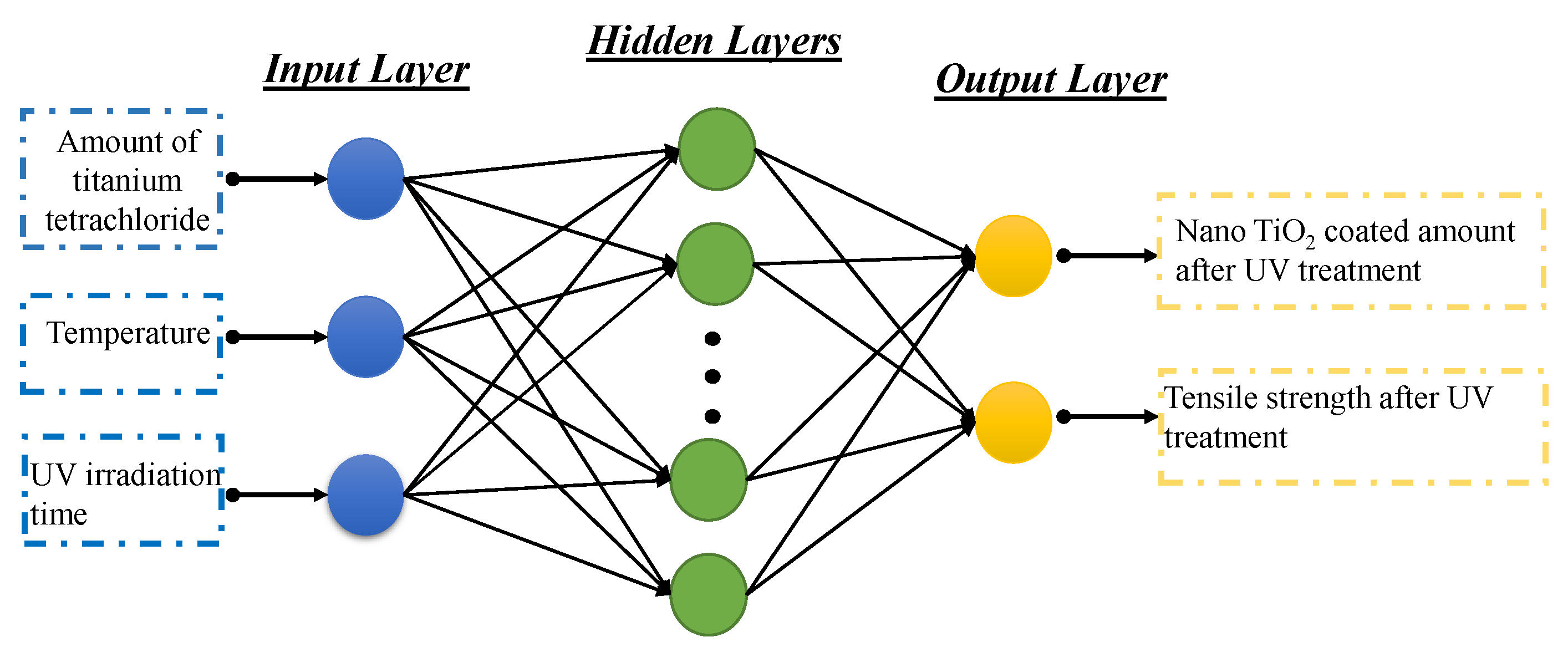

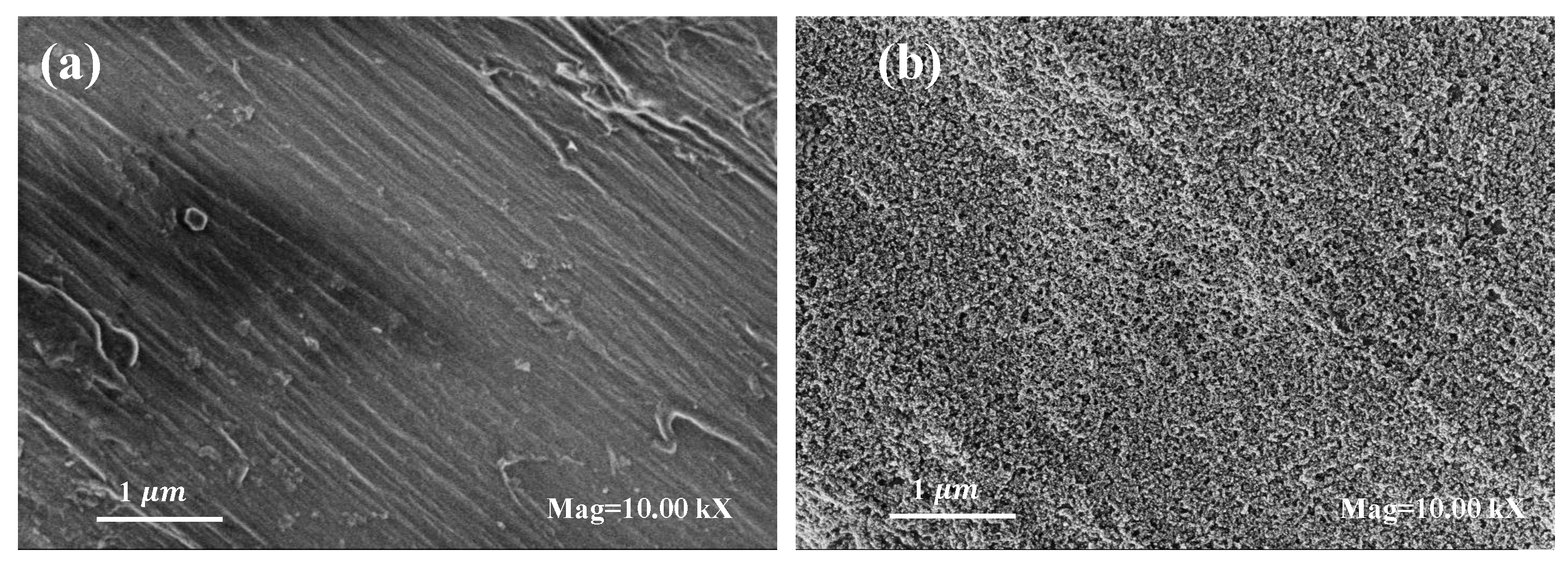

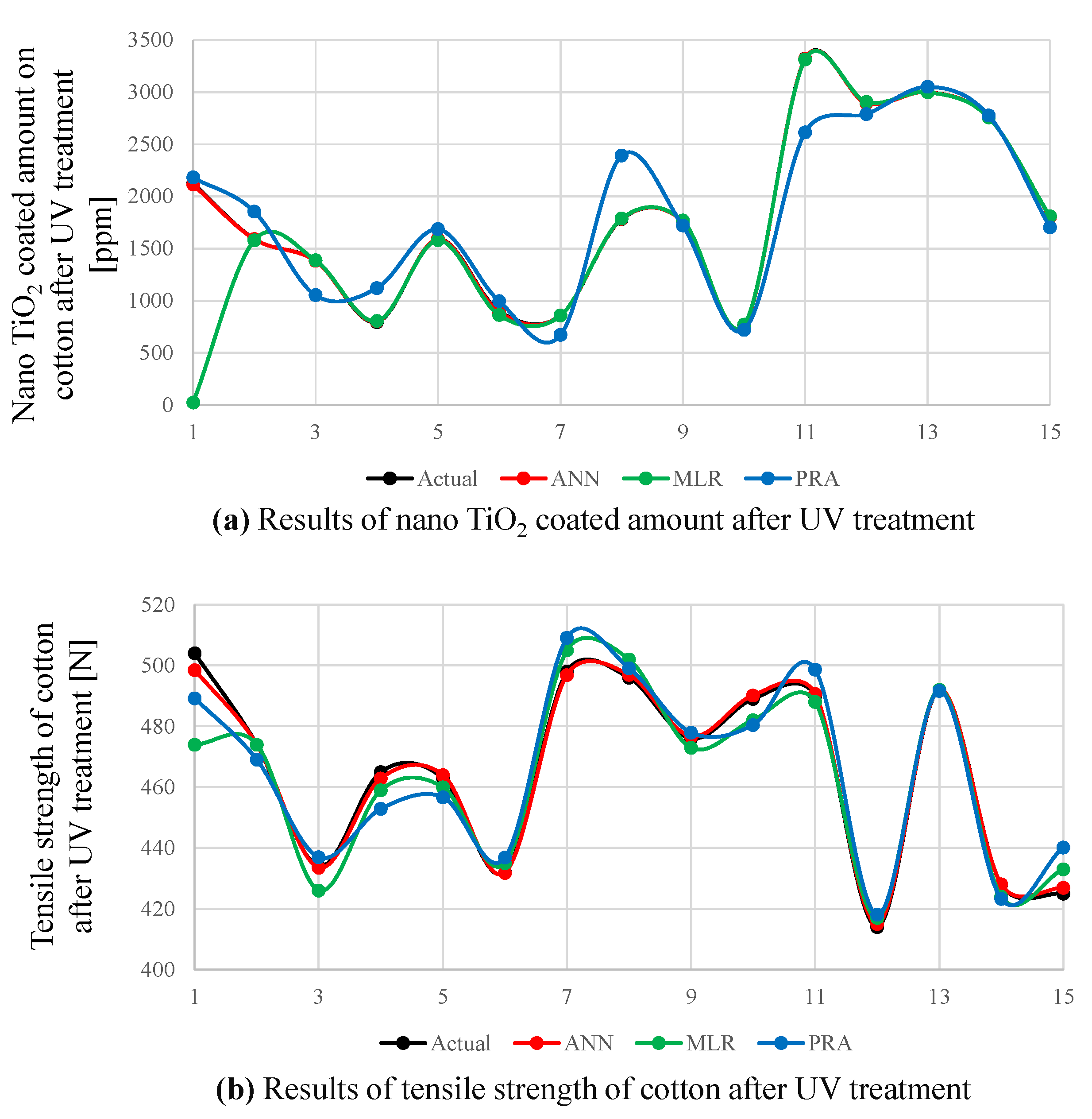

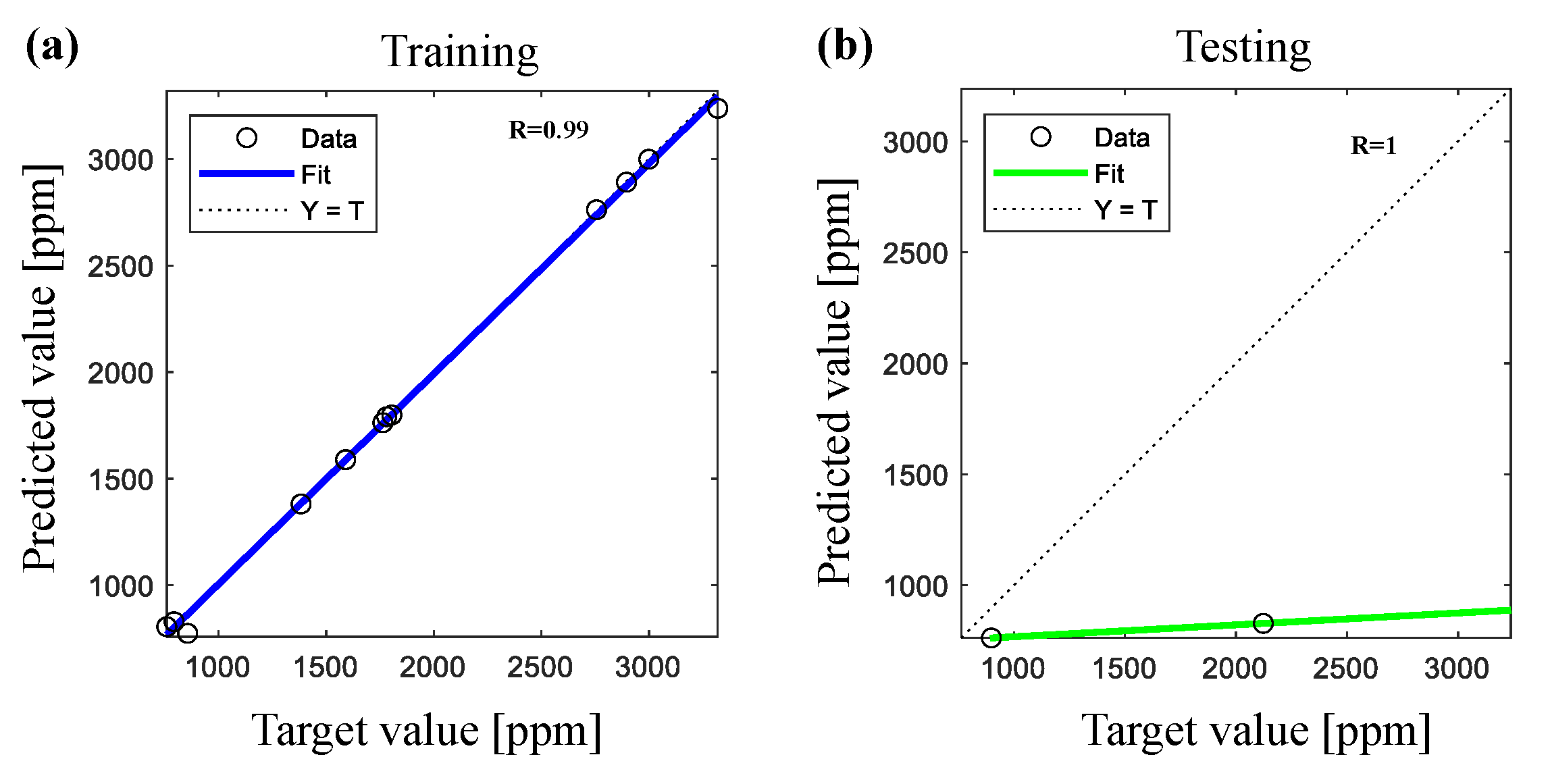
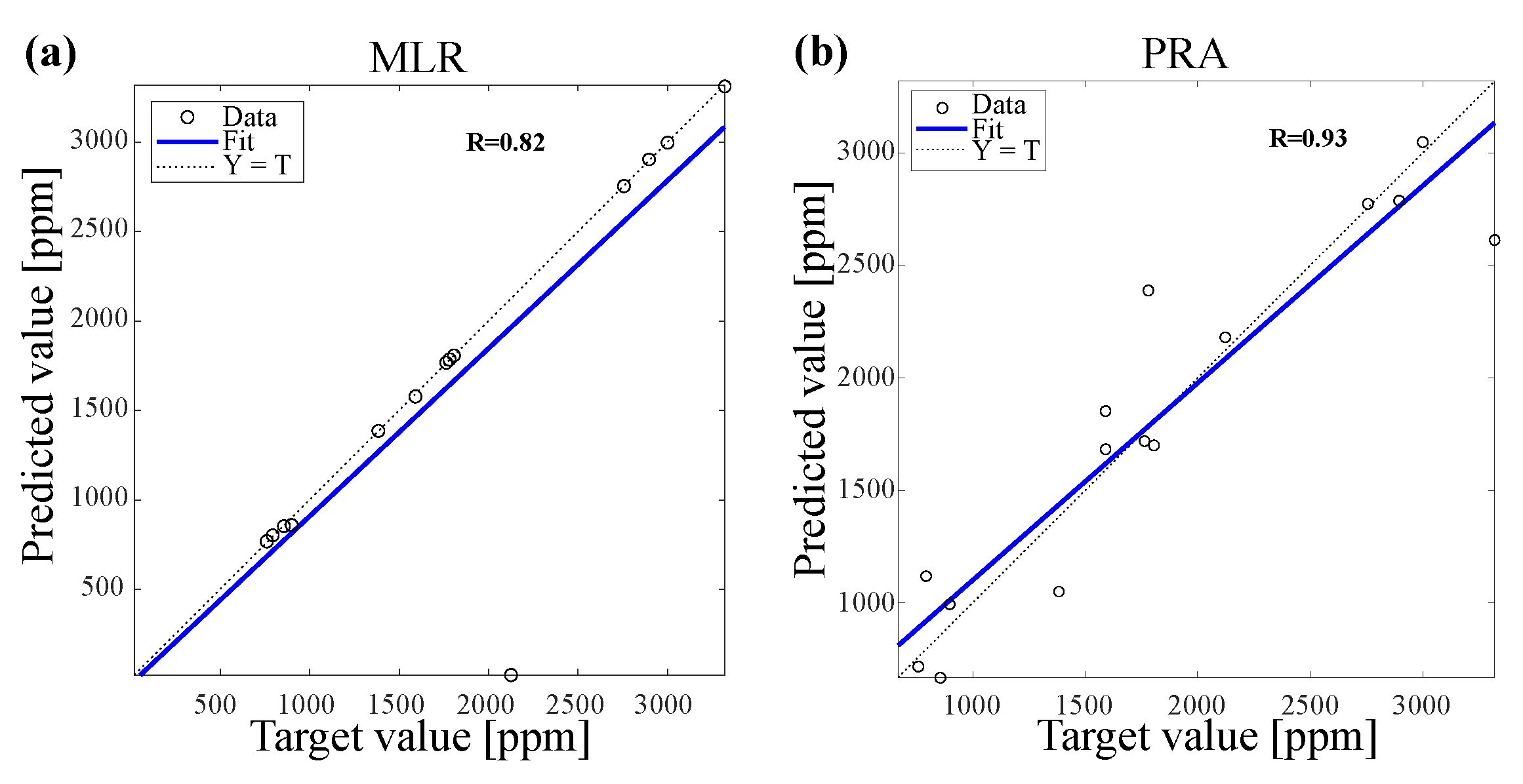
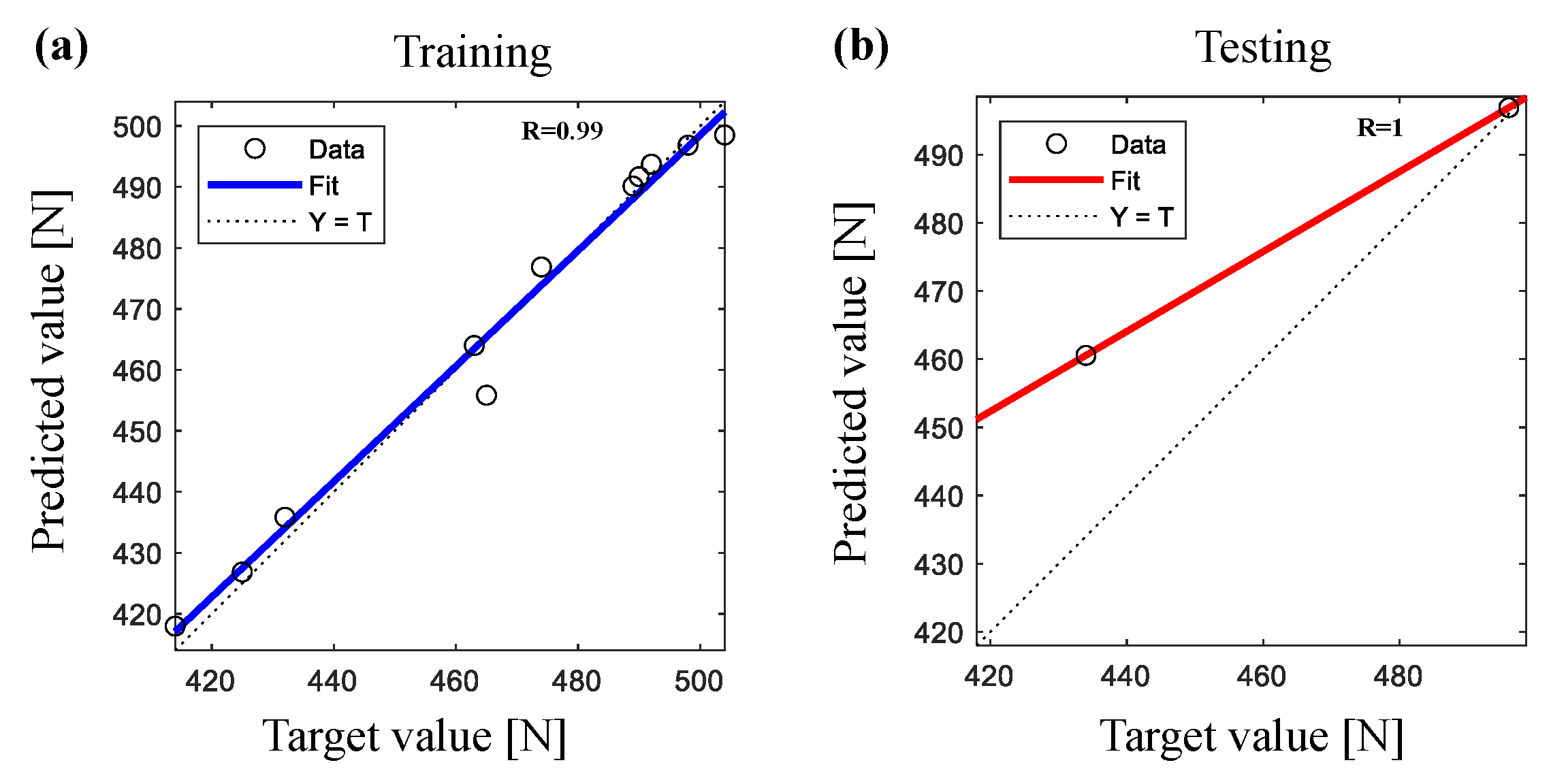
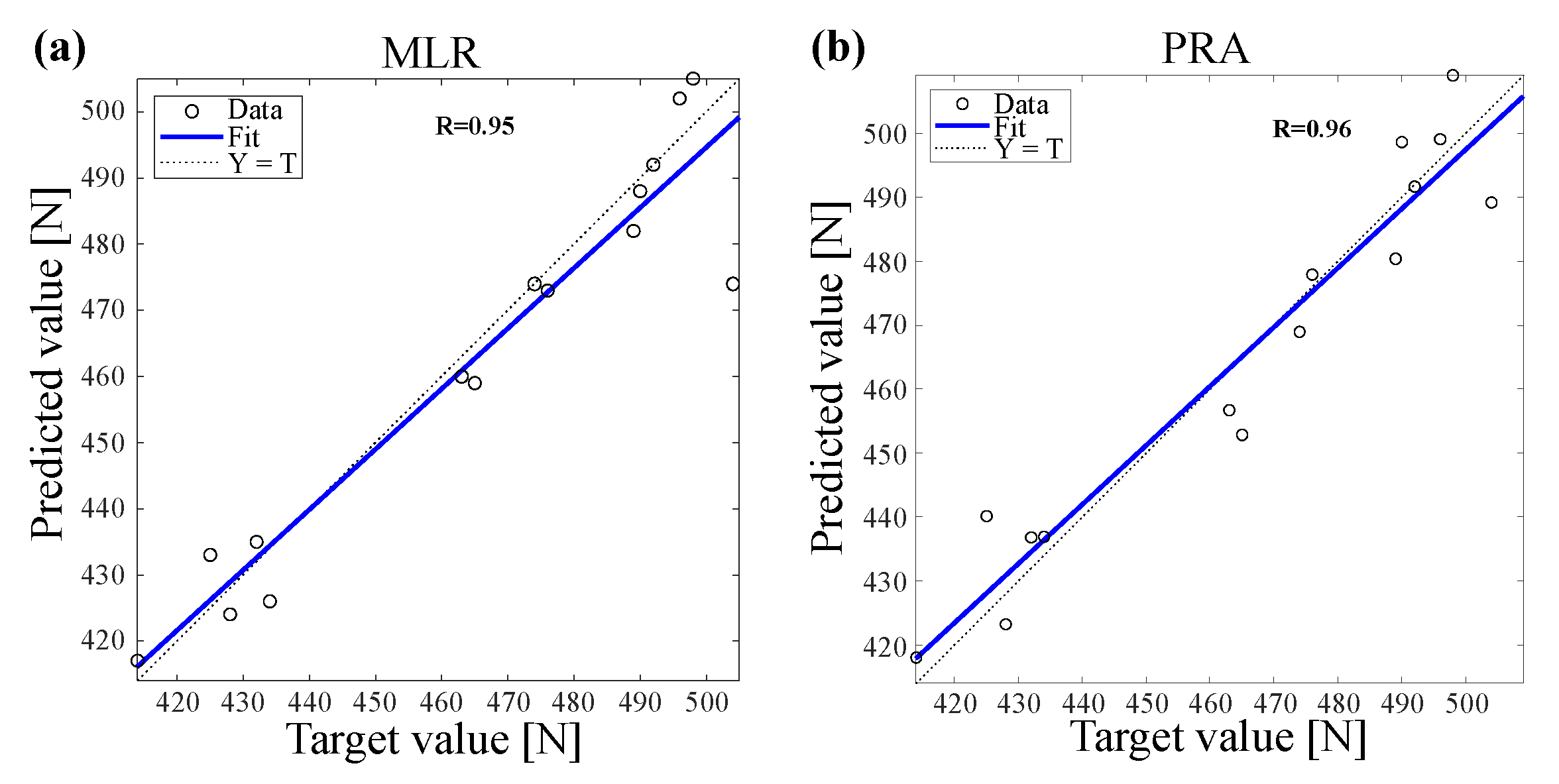
| Sample | TiO Dosage [g·L] | Temperature [°C] | UV Irradiation Time [min] |
|---|---|---|---|
| 1 | 6 | 70 | 80 |
| 2 | 4 | 30 | 120 |
| 3 | 6 | 45 | 80 |
| 4 | 6 | 45 | 15 |
| 5 | 8 | 30 | 40 |
| 6 | 4 | 60 | 40 |
| 7 | 4 | 30 | 40 |
| 8 | 8 | 60 | 40 |
| 9 | 6 | 20 | 80 |
| 10 | 2 | 45 | 80 |
| 11 | 8 | 60 | 120 |
| 12 | 8 | 30 | 120 |
| 13 | 10 | 45 | 80 |
| 14 | 6 | 45 | 150 |
| 15 | 4 | 60 | 120 |
| Parameters | Settings |
|---|---|
| Transfer function of hidden layers | tansig, tansig |
| Transfer function of output layer | tansig |
| Training function | trainbr |
| Performance goal | 0.00001 |
| Input node | 3 |
| Output node | 2 |
| Number of hidden nodes | 12, 12 |
| Epochs | 1000 |
| Functional Properties | Methods | MAE | MSE | RMSE | MAPE | R |
|---|---|---|---|---|---|---|
| Nano TiO-coated amount after UV treatment | ANN (training) | 2.94 | 20.18 | 4.52 | 0.23 | 1 |
| ANN (testing) | 2.86 | 20.05 | 4.47 | 0.22 | 0.99 | |
| MLR | 147.66 | 542.85 | 7.24 | 0.67 | ||
| PRA | 202.22 | 287.41 | 13.18 | 0.87 | ||
| Tensile strength after UV treatment | ANN (training) | 1.121 | 3.011 | 1.730 | 0.407 | 0.99 |
| ANN (testing) | 1.112 | 2.978 | 1.7257 | 0.2348 | 1 | |
| MLR | 6 | 83.6 | 9.1433 | 1.2703 | 0.90 | |
| PRA | 6.90 | 67.73 | 8.23 | 1.48 | 0.92 |
| Functional Properties | Methods | p-Value | F-Value |
|---|---|---|---|
| Nano TiO-coated amount on cotton after UV treatment | ANN | 0.0012 | 10.31 |
| MLR | 0.0024 | 9.92 | |
| PRA | 0.0041 | 9.17 | |
| Experimental | 0.0024 | 9.83 | |
| Tensile strength after UV treatment | ANN | 0.2163 | 1.98 |
| MLR | 0.3019 | 1.39 | |
| PRA | 0.34 | 1.23 | |
| Experimental | 0.2525 | 1.59 |
Publisher’s Note: MDPI stays neutral with regard to jurisdictional claims in published maps and institutional affiliations. |
© 2022 by the authors. Licensee MDPI, Basel, Switzerland. This article is an open access article distributed under the terms and conditions of the Creative Commons Attribution (CC BY) license (https://creativecommons.org/licenses/by/4.0/).
Share and Cite
Amor, N.; Noman, M.T.; Ismail, A.; Petru, M.; Sebastian, N. Use of an Artificial Neural Network for Tensile Strength Prediction of Nano Titanium Dioxide Coated Cotton. Polymers 2022, 14, 937. https://doi.org/10.3390/polym14050937
Amor N, Noman MT, Ismail A, Petru M, Sebastian N. Use of an Artificial Neural Network for Tensile Strength Prediction of Nano Titanium Dioxide Coated Cotton. Polymers. 2022; 14(5):937. https://doi.org/10.3390/polym14050937
Chicago/Turabian StyleAmor, Nesrine, Muhammad Tayyab Noman, Adla Ismail, Michal Petru, and Neethu Sebastian. 2022. "Use of an Artificial Neural Network for Tensile Strength Prediction of Nano Titanium Dioxide Coated Cotton" Polymers 14, no. 5: 937. https://doi.org/10.3390/polym14050937
APA StyleAmor, N., Noman, M. T., Ismail, A., Petru, M., & Sebastian, N. (2022). Use of an Artificial Neural Network for Tensile Strength Prediction of Nano Titanium Dioxide Coated Cotton. Polymers, 14(5), 937. https://doi.org/10.3390/polym14050937










